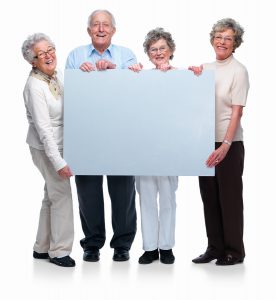How Caregiving Has Become a Routine Part of American Life
By Tess DiNapoli
America’s caregivers support the social and economic foundations of our society. As the population ages, more and more elderly adults need extra care on a regular basis. To address these needs, a significant and growing number of people are serving as caregivers to family members and others in their communities. In addition, we continue to face the challenges of COVID-19, which has caused many Americans to make the choice to keep their elderly relatives at home and provide care for them. These realities are making caregiving a more routine part of American life.
Who are the caregivers?
The number of Americans providing care for family and other members of their communities has grown over the last five years. According to an AARP study, 43.5 million adults in the United States are caregivers. The vast majority of those caregivers, 34.2 million, are providing care for adults 50 and over.
A substantial number of caregivers are also caring for more than one person, the majority of them being women, as they’re likely looking after both young children and their aging parents.
Multigenerational households
One of the growing realities in America is that many households span multiple generations. Older adults want to stay out of congregate senior care facilities as long as possible, and adult children often become their caregivers. To lessen the burdens of caregiving, a number of these adult children are choosing to bring their parents to live in their own homes with them.
Challenges of caregiving
Caregivers face a multitude of challenges as they provide support to older adults. The time commitment of caregiving is substantial, the financial strain can be significant, especially for unpaid caregivers, and the emotional stress of caring for others can affect the mental health and well-being of the caregiver.
Time challenges
The Family Caregiver Alliance indicates that family caregivers spend an average of over 24 hours providing care each week. This time commitment is on top of the demands of jobs, children, and social obligations. The number of hours a caregiver devotes to caregiving increases when the care recipient lives in the same household. The time commitment also increases with the age of the care recipient.
Financial challenges
When a caregiver is spending a significant number of hours providing care, they are not as available for extra work hours or more work responsibilities. As a consequence, caregivers are often forced to pass up promotions or cut their work hours, diminishing their own earning potential. These financial decisions can have long-lasting effects, potentially lowering social security benefits and retirement savings.
Mental health challenges
The American Psychological Association has identified several mental health concerns that are common among those providing senior care. Depression, anxiety, and guilt are some of the most prevalent challenges to the mental well-being of caregivers.
Benefits of caregiving
Despite these significant challenges, there are benefits to more routine caregiving in American life. Caregivers are less isolated with a growing number of other adults facing the same burdens. As caregiving becomes a more normal aspect of adult life, communities of caregivers help to ease some of the burdens and challenges they all face.
In addition, seniors benefit from remaining at home to receive care and support. They are not constrained by the schedules of care facilities and they can retain a degree of independence, which helps with mental well-being. Remaining in familiar surroundings can ease the strain and anxiety of aging as well.
Caregivers can help their care recipients to maintain their own mental health. One of the risks to elderly adults as they age is social isolation. They are not as able to get out of the house and socialize with their peers, whether due to physical limitations, no longer being able to drive themselves, or both. Caregivers provide much-needed companionship and can keep those in their care from getting lonely and depressed.
There are financial benefits as well. The costs of institutional care for the elderly are often prohibitive. Providing care to older adults in their homes is a cost-effective alternative for those who do not need around-the-clock care.
The reality is that the largest population in America, the baby boomer generation, is now aging. The care needs of these older adults will continue to be an increasing element of American society over the coming years, and we’ll need to prepare ourselves to meet that challenge as well.
Guest Blog: Three key ways architecture benefits the elderly
 Most people don’t realize just how big of an impact architecture can have on the lives and well being of elderly individuals. For many years, innovative designs for care homes and retirement living have gone a long way in helping to both support and reassure elderly residents so they feel comfortable in their surroundings, and will do for many years to come. Here are three key ways in which architecture benefits the elderly.
Most people don’t realize just how big of an impact architecture can have on the lives and well being of elderly individuals. For many years, innovative designs for care homes and retirement living have gone a long way in helping to both support and reassure elderly residents so they feel comfortable in their surroundings, and will do for many years to come. Here are three key ways in which architecture benefits the elderly.
Exposure to sunlight
One of the first architectural considerations for any residential project is ‘how does the building sit in relation to the sun?’ This can influence many factors such as the garden, conservatories and large windows, all because we want residents to have the best exposure to natural light as possible. Designs for many care homes ensure that there are no rooms that face exclusively north, so all residents receive direct, natural sunlight into their room at some point during the day. Not only are there psychological benefits of enjoying the sunshine, but exposure to the sun in moderation provides a healthy dose of Vitamin D, absorbed into the body to help strengthen bones which is a huge boost for the elderly to starve off the effects of frailty with age.
Green space
Residential architecture is not just about the building, but landscaping the garden area too. Retaining some green outdoor space is important for elderly residents for whom it may not be possible to venture to the nearest public park whenever they wish, so they can relax outdoors without completely leaving their home. For more mobile elderly residents, gardens also provide the opportunity to continue with a relaxing gardening hobby, or to even take it up. In care homes, gardens are kept in pristine condition all year round by qualified gardeners, and when the months begin to get warmer, residents can enjoy the various plants and colorful flowerbeds – some of which they may have helped to plant themselves.
Built to adapt
When it comes to care home facilities and retirement housing, architectural designs must cater for the ever-changing needs of the residents. Therefore, it has to be built to adapt. Many elderly who use wheelchairs will require spacious rooms with height adjustable surfaces, particularly in the kitchen, and ramps fitted on all entrances and exits. These features take even more prominence in care homes with more residents present, with designs also incorporating wide corridors to allow residents in wheelchairs or on mobility scooters to pass one another with ease, and interior walls within a resident’s living space fitted as panels that can be easily knocked out to create a larger open plan floor space if necessary.
Author bio: Mick Goode is a co-founder and co-director of Croft Goode Architects, based in Lancashire, UK. As a BIM-focused practice of chartered architects, we have a vast range of experience designing for all kinds of projects, including those for retirement living and healthcare buildings for the elderly and disabled.
The 6-Step Process of Stroke Recovery
According to the CDC, nearly 800,000 persons in the United States have a stroke each year. This is about one every 4 minutes, resulting in over 130,000 deaths annually. Stroke is simply defined as an interruption to the blood supply to the brain and is caused by a clot or hemorrhage. It can be a devastating problem for survivors, resulting in changes in mobility, cognition, speech, swallowing, bowel and bladder, self-care, and general functioning to varying degrees. Some people recover completely after a stroke, but others experience lifelong challenges.
The good news is that there is hope and quality of life after stroke. In my research with stroke survivors, I discovered 6 phases that survivors reported as they made the journey through rehabilitation towards recovery. These steps can be used to see where a person is in the recovery process, help us understand how they may be feeling, and help guide the way we interact with them.
Agonizing: In this first phase of the process, stroke survivors are in shock over what has happened to them. They can’t believe it, and may even deny the warning signs of stroke. The important task during this time is survival from the stroke itself. Call 911 if you see the warning signs of facial droop, arm weakness, or speech difficulties.
Fantasizing: In the second phase of the stroke process, the survivor may believe that the symptoms will all go away. Life will return to normal, and there is a sense of the problem being unreal. Time takes on a different meaning. The way to help is to gently help them recognize reality, and without taking away hope for recovery.
Realizing: This is the most important phase that signals a turn in the recovery process. This is when the survivor realizes that he/she may not fully recover from the effects of the stroke and that there is work to be done to rehabilitate and reclaim life. Common feelings during this phase of realizing are anger and depression. The way to help is to encourage the person to actively engage in rehabilitation. The real work of recovery is just beginning.
Blending: These last 3 phases in the process of stroke recovery may be occurring at much the same time. This is where the real work of adaptation to life after stroke begins. The survivor begins to blend his “old life” before stroke with his new life as a stroke survivor. He/she may start to engage in former activities even if it requires adaptations to be made. He/she will be actively engaged in therapy and finding new ways to do things. The way to help is to promote education. This is a time when survivors are most ready to learn how to adjust to life after stroke. Listen to your rehab nurses, therapists, and physician. Be active in the recovery process.
Framing: During this phase, the individual wants to know what caused the stroke. Whereas in the Agonizing phase they were asking “why me?”, now they need to the answer to “what was the cause?” Stroke can be a recurring disorder, so to stop a subsequent stroke, it is important to know the cause. Interestingly, if the physician has not given the survivor a cause for the first stroke, patients often make up a cause that may not be accurate. Help the survivor to learn from the health care provider what the cause of his/her own stroke was. Then steps can be taken to control those risk factors.
Owning: In this final phase of stroke recovery, the survivor has achieved positive adaptation to the stroke event and aftermath. The survivor has accomplished the needed grief work over the losses resulting from the stroke. He/she has realized that the effects may not go away and has made positive adjustments to his/her life in order to go on. Survivors in this phase have blended their old life with the new life after stroke and feel better about their quality of life. While they still may revisit the emotions of the prior phases at times, they have accepted life as a survivor of stroke and made good adjustments to any changes that resulted. They feel that they have a more positive outlook on life. At this point, survivors can use their experience to help others cope with life after stroke.
For more information about stroke recovery, visit www.seniorcarecentral.net and view Dr. Mauk’s model for stroke recovery.
Guest Blog: Inexpensive, Fun Activities For Seniors
Whether you’ve recently retired, are planning to retire soon or are facing an unknown future where retirement seems virtually impossible, when you’re living on a fixed or tight income, you’re always looking for ways to save money. Plus, since one of the first areas to get cut when the budget is tight is entertainment, you may wonder how can you still have fun, without spending a fortune. To answer that question, here’s a list of inexpensive activities that could be perfect for you!
Attend Free Events. From free nights at the museum to local art gallery showings in town, keep your radar on for free activities in the area that you might enjoy. Most cities will host free lectures, concerts, movie nights and other activities from time to time.
Start a Club or Discussion Group.
-
- Start a book club, movie group or discussion group with a handful of friends, hosted either at your home or rotating homes month to month. Getting together will cost little more than making some snacks — and it will still be a fun night for everyone.
Take Advantage of Community Centers and Libraries. Rent movies or check out books at the library, and go for walks at the local community center track. Within your specific city or town, find what other amenities are available to you and decide to make the most of them, either on your own or with a friend.
Volunteer in the Community. Volunteering not only makes you feel good about helping others, but it also connects you with people in the community and often qualifies you for some cool, cash-saving perks. Whether it’s free food when you’re volunteering at the local school district or a place to socialize when you’re serving as a greeter at the hospital, volunteering helps you reach outside yourself and have fun in the process.
Host Potlucks. Rather than always going out to eat with friends, try hosting potlucks where everyone brings a dish to pass. You’ll only need to make one dish, still have the fun of socializing with friends or loved ones, and save a bundle in the process.
Enjoy the Outdoors. Go to the park, take walks on trails at the forest preserve, plan a picnic or watch a local Little League game. Getting outside is not only good for your spirits, it’s usually inexpensive too!
Mark Westerman is the Chief Marketing Officer for CareOne, Inc., a provider of debt relief services nationwide.


